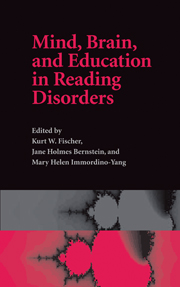Book contents
- Frontmatter
- Contents
- List of figures
- List of tables
- List of contributors
- Acknowledgements
- Part I What is Reading, and What are Reading Disorders? Looking to Neuroscience, Evolution, and Genetics
- Part II Reading and the Growing Brain: Methodology and History
- 4 A brief history of time, phonology, and other explanations of developmental dyslexia
- 5 Approaches to behavioral and neurological research on learning disabilities: in search of a deeper synthesis
- 6 Growth cycles of mind and brain: analyzing developmental pathways of learning disorders
- Essay: Cycles and gradients in development of the cortex
- 7 Brain bases of reading disabilities
- 8 The neural correlates of reading disorder: functional magnetic resonance imaging
- 9 Patterns of cortical connection in children with learning problems
- Essay: The role of experience in brain development: adverse effects of childhood maltreatment
- Part III Watching Children Read
- Part IV Reading Skills in the Long Term
- Appendix: Transcript and behavioral data from Profiles in Reading Skills (Four Boys)
- Index
- References
8 - The neural correlates of reading disorder: functional magnetic resonance imaging
Published online by Cambridge University Press: 22 September 2009
- Frontmatter
- Contents
- List of figures
- List of tables
- List of contributors
- Acknowledgements
- Part I What is Reading, and What are Reading Disorders? Looking to Neuroscience, Evolution, and Genetics
- Part II Reading and the Growing Brain: Methodology and History
- 4 A brief history of time, phonology, and other explanations of developmental dyslexia
- 5 Approaches to behavioral and neurological research on learning disabilities: in search of a deeper synthesis
- 6 Growth cycles of mind and brain: analyzing developmental pathways of learning disorders
- Essay: Cycles and gradients in development of the cortex
- 7 Brain bases of reading disabilities
- 8 The neural correlates of reading disorder: functional magnetic resonance imaging
- 9 Patterns of cortical connection in children with learning problems
- Essay: The role of experience in brain development: adverse effects of childhood maltreatment
- Part III Watching Children Read
- Part IV Reading Skills in the Long Term
- Appendix: Transcript and behavioral data from Profiles in Reading Skills (Four Boys)
- Index
- References
Summary
Overview: Functional magnetic resonance imaging (fMRI) provides a powerful tool for analyzing brain correlates of reading problems, although conclusions must be qualified by methodological confounds that researchers need to examine. Theoretical analyses of diverse patterns of dyslexia suggest three different impairments in phonological, visual, or auditory skills. Recent research with fMRI indicates that distinct brain regions most likely show reduced activation for each of these problems. For children with phonological problems, reduction is in left temporo-parietal regions, which are involved in speech. For those with visual problems, reduction is in the magnocellular system, which is involved in vision. For those with temporal processing problems, reduction seems to include the frontal and left temporal areas.
The EditorsEver since Dejerine's work implicated the left angular gyrus as playing a special role in impairments of reading and writing, neuroscientists have recognized the importance of understanding the neural underpinnings of dyslexia (Dejerine, 1891). The invention in the 1990s of functional magnetic resonance imaging (fMRI), a non-invasive neuroimaging technique, allows unprecedented access to the human brain at work at spatial resolutions of millimeters and temporal resolutions of seconds. (Some analysis techniques push this resolution even lower.) Findings have mirrored differences found in morphological studies with prior techniques, and gone beyond them: on the order of a dozen different brain regions have been shown to have different blood flow patterns during reading-related tasks in dyslexics as compared to normal readers.
- Type
- Chapter
- Information
- Mind, Brain, and Education in Reading Disorders , pp. 148 - 167Publisher: Cambridge University PressPrint publication year: 2007
References
- 2
- Cited by



